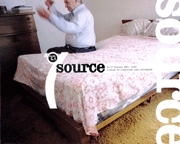Utopia and the Train-set
Concrete Dreams by Tom Merilion was at Belfast Exposed, April 2001
Review by Colin Graham
Issue 27 Summer 2001
View Contents ▸
In Tom Merilion's photographs Birmingham is utopian, chromatic and vertiginous. Halfway into the exhibition is an image which, at first glance, seems out of place. Why the insides of a computer in the middle of an exhibition of urban spaces? A closer look at those regularly patterned, glossy Little nodes of colour and they transform into cars in a car park, shot from an aeroplane, and then the vertigo sets in. Because you're falling into this photograph. It's an extraordinary feeling, produced again and again in different ways by these images, which vary their angle from bird's-eye to roof-level to ground-level, yet still within each the space between the camera's point of view and the places photographed shimmers and moves. The effect is achieved with apparent simplicity; the edges of these images (particularly top and bottom quarter) are out of focus, manipulated so that in some sense they imitate the blurred edges of every day vision. And then if you can tear yourself out of the falling feeling these images induce, it's re-invented by the hint of Vaseline-on-the-lens nostalgia which threatens to tip you back into the past.
Merilion collapses the large-scale built environment into the lovingly intimate space of the architect's model. His insistence on the beauty and complexity of (post-)industrial space transforms the real world of failed postwar British planning into a train-set. This is a refusal to accept the intimidating scale of these buildings and mapped out spaces, a recasting of the original vision in the most humane of terms while recognising its potentially alienating effects. The collection laments the passing of the futurist drive which recreated a city like post-war Birmingham. In this sense these photographs are an act of reclamation and a celebration. The shapes of the Bull Ring shopping centre and the simple, bold lines of its circling staircases look to have expected shopping in the second half of the twentieth century to be raised to a level of social and civic granduer it never achieved. For all the complexity of these spaces, Merilion captures, in perfect sunlight and under blue-tinted postcard skies, the stunning naivete of this planner's vision and its belief that a community ideal was best expressed in geometric confidence. Birmingham New Street Station
Birmingham New Street Station
Generally the exhibition depopulates the city, giving it the appearance of a place waiting for the future to happen. In one photograph, however, commuters use a walkway, flanked on either side by two large glass-panelled sloping walls - the living are in this modet, but they are pLaying out the lives of the faceless, casual bystanders in architectural sketches. The partial sphere of shops, undoubtedly meant to open out to the public world and provide a cupped comfort at the same time, is undercut by the much later addition of the camera. It's only a tiny detail, but it shows us reassuringly that Merilion knows exactly what. he is doing, and that he sees the strangeness involved in turning the recent into a form of impossible nostalgia.
Concrete Dreams also has a sense of narrative; going clockwise round the gallery it moves from the city centre into suburban housing estates and shows how their winding and unpredictable pattern of street shapes attests to an adventureness in the idea of suburbia which is always betrayed at ground level. The most rural image is crossed vertically by gleaming train tracks, paralleled by tractor marks scarring grass which is painfully, lushly green. After this and the city itself, Birmingham International Airport looks bleached and dull. If this, for the first time, pushes the viewer towards something disappointing in this nearly imaginary world, the clouds literally gather with a largely ungarnished photograph of a partially demolished tower block which seems to suggest that changes are imminent and inevitable. So the final images of train tracks leading into Birmingham New Street Station are all the more poignant, since in them the city looks precariously balanced on tectonic plates above the rail system; the city, temporary and shiftable, has become as fragile as Merilion's images of it. NEC Car Park
NEC Car Park
Along with the photographs in Concrete Dreams are four lightboxes, their spyholes taking us through an experiential twist of Victoriana while creating 60s 3-D images of the Bull Ring. Like the rest of the exhibition, they are a wise and intelligent testimony to the lost enthusiasm of the postwar dream. Merilion doesn't condemn or ridicule this profoundly social idea. He makes his city distant, a sci-fi place that never existed as it should have done, but he also pays homage to the utopianism practice it lost the very moment it was put into practice.
Other articles by Colin Graham:
Other articles on photography from the 'Architectural' category ▸






